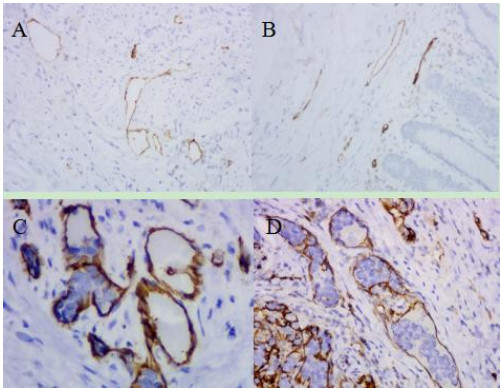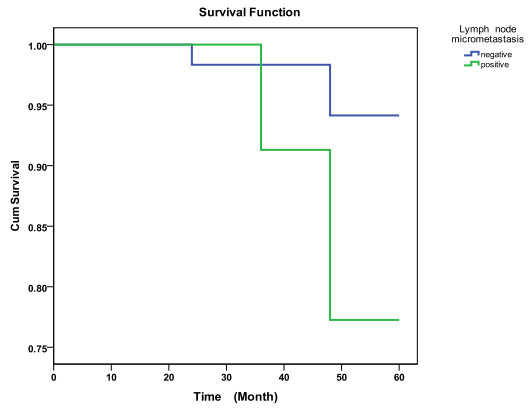1.
Introduction
Gastric cancer is one of the most common malignancies, and the second leading cause of cancer-related deaths in the world [1]. Early gastric cancer (EGC) 5-year survival rate is more than 90% [2]. Lymph node metastasis is the most important prognostic factor in patients with EGC. However, some patients with EGC who had undergone surgical treatment and had no lymph node metastasis confirmed by conventional pathology were still discovered to have recurrence or metastasis. LMM is clusters of cancer cells or even just several cancer cells in lymph nodes, with diameters of 0.2–2 mm. LMM is not rare in EGC patients, with an incidence of 10%–31.8% [3,4,5,6]. LMM-positive EGC patients may have a lower 5-year survival rate and a higher recurrence rate [7,8]. Recently, the technology of endoscopic submucosal dissection (ESD) has been developed rapidly in the treatment of EGC and gradually extended to submucosal groups of EGC. However, the procedure of ESD does not remove these lymph nodes, and the key of its indication is absence of lymph node metastasis. How about the incidence of LMM in these patients? How about the clinical significance of the micrometastasis in EGC? It is necessary for us to make them clear.
2.
Materials and method
2.1. Patients
We retrospectively reviewed the data of 106 patients with T1N0 EGC (adenocarcinoma) who underwentD2/D2+curative gastrectomy at Zhejiang Provincial People's Hospital from January 2012 to July 2016, without chemotherapy and radiotherapy before surgery. All patients were diagnosed as EGC by routine HE staining, with no lymph node metastasis.
2.2. Immunohistochemical staining for detection of micrometastasis
2.2.1. Lymph node micrometastases
Every dissected lymph node from each patient was inspected. Five consecutive slices of the lymph node in the part of the largest diameter were selected. CAM5.2 antibodies (combined antibodies of cytokeratin CK8 and CK18) were used for immunohistochemical staining to detect LMM. The positive expression was defined as brown granules in the cytoplasm of metastasis carcinoma cells.
2.2.2. Detection of lymphatic vessels in primary cancer foci
D2–40 monoclonal antibody was used for detecting lymphatic vessels, and immunohistochemical staining was performed according to instruction. Serial sections 3um thick from the primary cancer were employed. The positive expression of D2–40 was localized in the lymphatic endothelial cell membrane and cytoplasm, dyed into brownish yellow. Lymphatic vessel density (LVD) was determined according to Weidner's method [9]. Single endothelial cells or endothelial cell clusters with positive staining were considered as one LVD, according to D2–40 staining.
2.3. Statistical analysis
SPSS 19.0 software for Windows (SPSS Inc. Chicago, IL, USA) was used for statistical analysis. Overall survival rate and disease-freesurvival rate were analyzed by using the Kaplan-Meier method. Relevance between LMM and clinicopathological parameters of T1N0 EGC was analyzed using the Chi-Square test, Fisher’s exact test and t test. A p value < 0.05 was considered statistically significant.
3.
Results
3.1. LMM and lymphatic invasion in T1N0 EGC
LMM was detected in 22 out of 106 cases with T1N0EGC, with a detection rate of 20.8%. Twenty-four of all dissected 2165 lymph nodes from the 106 patients showed positive LMM, with a detection rate of 1.11%. Eight of the 106 cases were found positive lymphovascular invasion (LVI) by routine HE staining. Otherwise, D2–40 staining revealed another positive LVI. The IHC staining of LMM and the D2–40 staining of LVI are shown in Figures 1 and 2, respectively.
3.2. Impact of LMM on survival of T1N0 EGC
A total of eight patients out of the 106 patients could not be tracked down after their operation. Lymph node metastasis occurred in 4 of the remaining 98 patients. Two of the 22 cases with positive LMM were detected to have celiac metastasis after surgery, corresponding two out of 76 negative LMM cases. The median survival time in the LMM negative group seemed higher than that of LMM positive group (60 months vs 48 months). However, the Kaplan-Meier analysis showed P > 0.05, with no statistically significant differences. The follow-up data and survival analysis are shown in Figure 3.
3.3. Correlation between LVI and survival of T1N0 EGC
Nine of the 106 T1N0 EGC patients showed positive LVI with IHC by D2–40, three of which died of celiac lymph node metastasis during the follow-up period. On the contrary, only one of the 89 T1N0 EGC cases with negative LVI had celiac lymph node metastasis. Median survival time was 60. Xx months in the LVI negative group, vs 42.25 months in the LVI positive group. The log-rank test showed P < 0.001, so the difference in median survival time was statistically significant.
3.4. Correlation between LMM and clinicopathological features inT1N0 EGC patients
The Fisher’s accurate test showed a statistically significant correlation between invasive depth of T1N0 EGC and LMM, namely, submucosal EGC was more likely accompanied by LMM than mucosal EGC. Similarly, LVI positive EGC patients seemed more likely to be followed with LMM than LVI negative patients. Three out of the nine cases with LVI positive EGC were detected with LMM, while 19 of the 97 cases with LVI negative EGC were found LMM (P < 0.05). The t test was employed to evaluate the correlation of LMM with age, tumor size and lymphatic vessel density; and no statistically significant difference was found. The Chi-square test was used to analyze the incidence difference of LMM among different groups according to sex, EGC location, EGC general classification, and adenocarcinoma differentiation; no statistically significant difference was found. Results are shown in Table 1.
3.5. Lymph node micrometastasis and indications of ESD in TIN0 EGC
In this study, we analyzed the occurrence of LMM in EGC patients that met the indications of ESD. Of the 106 T1N0 EGC patients, seven cases were in accordance with absolute indications of ESD, and none was found with LMM. In the other 30 patients conforming to expanded ESD indications, six cases were detected with LMM. All of the six cases were in accordance with the third group of expanded ESD indications: no ulcer, tumor diameter less than 3 cm and differentiated SM1 submucosal carcinoma. Details are shown in Table 2.
4.
Discussion
It is not easy for LMM to be discovered during routine examination using CT, ultrasonography, Doppler, MRI, and even HE staining pathology [10]. The techniques of immunohistochemistry and molecular biology made it possible for us to find LMM in T1N0 EGC patients. Cytokeratin (CK) and carcinoembryonic antigen (CEA) are the most Frequently-used markers for diagnosis of micrometastas is in gastrointestinal tumors, and CK might be more sensitive than CEA [11]. Compared to the single marker of CK or CEA, the combination of them can obviously increase the detection rate of LMM (add citations). In this study, the combination of CK8 and CK18 were used for detection of LMM in T1N0 EGC patients, and it revealed an incidence rate of 20.8%.
LMM may imply worse prognosis with higher post-operative recurrence rate. LMM positive T1N0 EGC was accompanied with lower 5-year survival rate than LMM negative group [7]. It was supported by a similar conclusion from a meta-analysis published in 2015 [12]. LMM was detected in 50% cases of T1N0 EGC patients with recurrence or metastasis [8]. In our study, the LMM positive EGC showed a tendency of lower median survival time than the LMM negative group, with 48vs60months. But the log-rank test did recognize any statistically significant difference. It may be attributed to our small size of samples. It depended on multiple factors whether LMM developed into a macro-metastasis foci, such as the proliferative activity of the LMM, host-related immune defense and chemotherapy. The disparity of the above-mentioned factors may lead to contrary results in different studies.
We analyzed the correlation between LVI and the prognosis of T1N0 EGC. The LVI positive EGC patients showed lower median survival time and lower cumulative survival ratio compared with the LVI negative group. LVI seemed to be an independent risk factor for lymph node metastasis and poor prognosis in EGC patients.
It was reported that LMM was related to the invasion depth of gastric cancer. Incidence of LMM was more common in gastric cancer invading the muscularis propria and Serous layer than that in EGC, 42.9% vs 30%. It was not clear whether there was any difference of the LMM incidence between submucosal EGC and mucosal EGC. In this study, we found that LMM incidence in submucosal EGC was significantly higher than that in mucosal carcinoma, 23.9% vs 0%.
LMM was reported to be related to LVI. It has been confirmed in T1 colonic cancer [13,14]. However, it was not clear whether LMM was associated with LVI in EGC. We showed that the incidence rate of LMM was significantly higher in LVI positive EGC than in LVI negative group. It was considered that histological differentiation of gastric cancer was involved in occurrence of LMM. Incidence of LMM in diffuse gastric carcinoma was reported at 56%, significantly higher than that of 28% in intestinal gastric carcinoma [15]. We did not find any statistically significant difference of LMM incidence from well differentiated EGC (papillary adenocarcinoma, tubular adenocarcinoma and) and poorly differentiated EGC (low differentiated adenocarcinoma, signet ring cell carcinoma, undifferentiated carcinoma, and mucinous adenocarcinoma). On the one hand, it was probably because of the small sample size used in our study. On the other hand, the effect of carcinoma differentiation on lymph node metastasis in EGC might not be so significant as that in advanced gastric cancer.
Lymphatic vessels in the primary foci is considered to be related to lymphatic metastasis of malignant tumor. It was reported that the LVD of the primary cancer was associated with lymph node metastasis [16,17,18]. Is there any correlation between LVD and micrometastasis in EGC? If LVD could predict micrometastasis or lymph node metastasis in EGC, it should be a significant indicator for pathological evaluation after ESD. So, we analyzed the lymphatic vessel density of LMM positive EGC and LMM negative groups. LVD in the positive EGC patients seemed higher than that in the negative group, but no statistically significant difference was found.
It was common to have incidence of LMM in T1N0 EGC patients. LMM might be associated with higher chances of abdominal metastasis and recurrence, and with a lower median survival in T1N0 EGC patients. LMM was related to the infiltration depth of EGC, and was more common in submucosal EGC than in mucosal EGC patients. LMM was found in the EGC according to expanded ESD indications.
Acknowledgments
This study was supported by the Funding Project of Health and Family Planning Commission of ZheJiang province (201468463), the Funds of Science Technology Department of Zhejiang Province (no. LGF19H160027).
Conflict of interest
No conflict of interest was declared by the authors.










 DownLoad:
DownLoad:





